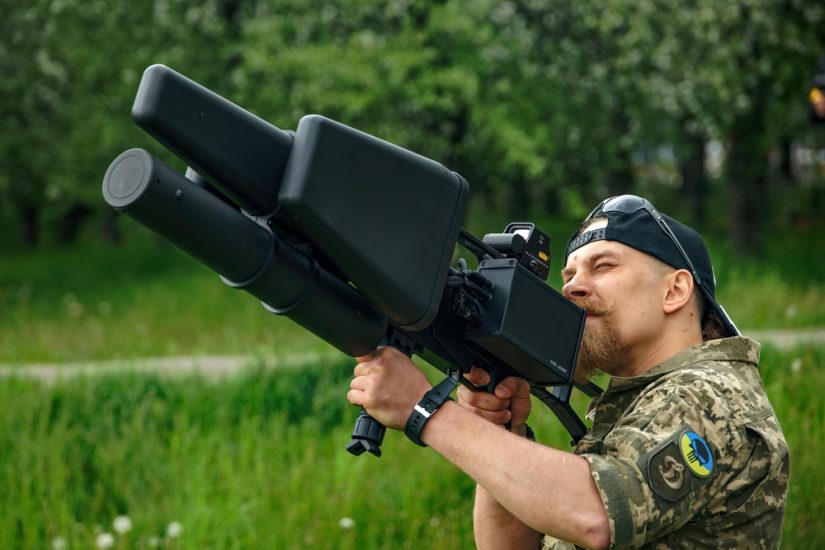By Philip Butterworth-Hayes
At the start of 2023 the next phase of the drone/counter-drone war began in earnest in Ukraine. With new, more lethal, loitering munitions being deployed by both sides, new, more capable counter-UAS systems have also been sent into battle (See also box: “Western allies ramp up supplies of counter-UAS equipment to Ukraine”)
The start of the year saw a wave of Russian drone strikes against Ukrainian civil targets followed by a wave of Ukrainian drone strikes against targets in in southern and western Russia. These attacks were another catalyst in the process of both sides rapidly increasing the number and effectiveness of their C-UAS capabilities.
During the last few months of 2022, new more lethal drones began appearing on the battlefield. As previously reported, many Ukrainian counter drone systems proved inadequate in dealing with Russian loitering munitions such as the Zala/Kalashnikov Lancet-3 or Iranian Shahed-136 suicide drones.
But a large number of these Shahed drones have been shot down. According to a report from the UK’s Royal United Services Institute (RUSI): “The Ukrainians claim a success rate of between 50% and 70% in defending against them – (but) they have still inflicted considerable damage, even with their relatively small warheads. President Volodymyr Zelenskyy conceded their effectiveness in his 21 December speech to the US Congress, where he said that ‘Iranian deadly drones, sent to Russia in [their] hundreds, became a threat to our critical infrastructure’.”
“Kamikaze drones have become a real headache for Ukrainian troops….,” according to Belgian C-UAS analyst Tim de Zitter posting on Linkedin. “Because the drone is guided to the target using tactical reconnaissance such as Orlan-30 or Zala, it is very difficult to detect the approaching Lancet or Kub in advance, and it is also challenging to jam the radio control channel because at the final stage, it is already controlled by an inertial system.”
And according to a blog by C-UAS company Droneshield. “Smaller drones can be used in four ways in warfare: precise payload delivery (such as dropping explosives or kamikaze attacks), surveillance (scouting out enemy positions to send a mortar or otherwise coordinate an attack), nuisance/loitering and cyber/hacking (using proximity to enemy networks to hack in via a drone, and degrade/infiltrate the networks).”
For Russia, ramping up battlefield C-UAS capabilities has meant changing the focus away from large-scale air defence units to developing a new generation of more mobile systems aimed specifically at targeting small drones.
At the start of January, it was reported that: “mass production of new electronic warfare and anti-unmanned aerial vehicle (UAV) systems will start in the next couple of months,” in Russia. “Within one to two months it is planned to complete state tests and switch to mass production of a fundamentally new generation of aviation and ground electronic warfare and combat UAVs.” Russian state-owned defence enterprise Rostec said on Telegram.
What kind of new C-UAS weapons will these be?
It is clear that Russia has quickly developed and produced new ranges of lightweight C-UAS systems capable of engaging small commercial drones, some of which were on display at the recent IDEX exhibition (See: New range of lightweight Russian C-UAS systems were in on display at IDEX 2023).
For example, Russian firm St Petersburg’s PPSh Laboratory has recently unveiled the LPD-802 electronic warfare gun. According to a November TASS report: “Currently, the LPD-802 drone jammer is undergoing all the required tests. The LPD-802 has its interior design completely renewed and features smaller dimensions, which is vital in its operation. Compared to the LPD-801 model, the LPD-802 boasts enhanced power and an extra jamming frequency band to suppress American drones.”
SVD and SVD-S sniper rifles are now equipped with thermal imaging sights and portable laser devices to target small drones at a distance of 300-700m and Russia’s Military Thought magazine in January carried an article which hinted at the development of a new universal remotely controlled combat module (RSWM) with an automatic guidance system and tactical augmented reality goggles, specifically to tackle the threat of small drones. The new system would integrate remote control, automatic aiming, microwave detection, tracking and suppression, via a low-power laser and MANPADS, all within a common mission management module.
For its part, Ukraine has seen a rapid escalation in C-UAS equipment supplies over the last few months (see: “Western allies ramp up supplies of counter-UAS equipment to Ukraine”). These new, more capable systems are taking a heavy toll on Russian drone attacks.
In a November 2022 Stimson Center on-line seminar, “Ukraine and the Future of Air Warfare.” Samuel Bendett, a Russia studies expert from the CNA policy centre said he’s seen figures from 60-90 percent of these drone attacks destroyed through accurate C-UAS counter-measures, but all it takes its for one of these UAVs to make it through to take out power plants, water distribution systems and other civilian infrastructure. It is unlikely that Russia yet worked out how to use drones with an artificial intelligence, according to a report of the proceedings “such that they coordinate with each other through machine intelligence, but they are sometimes used in “swarms” that make targeting a challenge – although a better word is “mass”, rather than “swarms.”

NASAMS – Raytheon
According to the RUSI report – “On 30 November, the spokesman of the Ukraine Armed Forces (AFU) claimed that out of 400 Iranian Shahed UAVs launched to date, 340 (85%) were shot down.”
In Ukraine latest mass attacks of kamikaze drones are slowly being countered by more numerous and effective current generation C-UAS systems – though considerably more systems will be needed to counter the upcoming Spring offensive and protect civilian infrastructure from more lethal drone attacks.
But the next problem is to develop C-UAS capabilities which can effectively deal with more organised swarms of drones, coordinated through AI, which would present both sides with a new, considerable C-UAS challenge.
| Western allies ramp up supplies of counter-UAS equipment to Ukraine
The following is a list of some of the main supplies of C-UAS systems to Ukraine from its allies. The list is not exhaustive and based on information supplied in the public domain. However, it gives some indication of the increase in the number and sophistication of the counter-UAS systems deployed in the country.
|
For more information
https://www.politico.eu/article/ukraine-drone-academy-war-russia-kyiv-pilot/
https://apnews.com/article/russia-ukraine-war-attacks-drones-63b875b1acf0e65b469af4e49b96c844
https://www.droneshield.com/blog-posts/lessons-from-drones-in-ukraine-war
https://edition.cnn.com/2023/03/01/europe/russia-ukraine-drones-alleged-attacks-intl-hnk/index.html
https://mil.in.ua/en/news/ukraine-will-receive-titan-counter-uav-systems-from-the-usa/
https://www.thedefensepost.com/2022/05/17/russia-anti-drone-units-2/
https://www.thedefensepost.com/2022/11/02/russia-upgraded-drone-jammer/
(Image: Shutterstock – Ukrainian army units testing an EDMS portable antidrone jammer)




